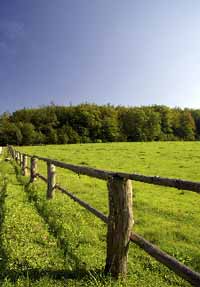



Using Poultry Litter in Tall Fescue Seed Production
Poultry litter is suitable for tall fescue (grass) seed production if the soil needs nitrogen, phosphorus and potassium, writes Travis Harper, extension aronomy specialist at the University of Missouri.Poultry litter has long been used as a source of nitrogen, phosphorus and potassium on crop, pasture, and hay ground and for good reason. The nutrient content of poultry litter can vary significantly depending on source but in general, a ton of poultry litter contains approximately 55 pounds of nitrogen, 55 pounds of phosphate and 45 pounds of potash. To purchase these nutrients in commercial form, it would cost approximately 75 dollars at today’s prices. Considering one ton of poultry litter costs 45 dollars delivered and spread, using this alternative fertilizer source can result in significant savings. There are a few other things to consider, however, before deciding to use poultry litter on tall fescue meant for seed production.

As mentioned above, the nutrient content of poultry litter can vary significantly depending on the source of the litter. If poultry litter is to be used, it is important to find out exactly how much of each nutrient is present in the litter. Applying poultry litter with a nutrient content less than what is expected may result in the needs of the crop not being met. Using poultry litter with a nutrient content higher than expected may result in extra amounts of one or more nutrient being applied in the soil. Over a period of time, this extra application of a nutrient can result in excessive soil test levels, leading to diminished nutrient availability or even water quality issues. The nutrient content of poultry litter should always be analyzed prior to field application.
Nitrogen in poultry litter exists in two forms: organic and inorganic. At the time of application, only about ten per cent of poultry litter is inorganic, or immediately available to the plant. The rest of the nitrogen, or the organic portion, becomes available over a period of about six months. As a result, poultry litter can be classified as a slow-release fertilizer, and therefore works better in situations where small amounts of nitrogen are needed over time, such as in a pasture system, as opposed to a cropping or hay system where a large amount of nitrogen is needed in a short period of time.
In addition, only about half of the nitrogen in poultry litter ever becomes available to the plant meaning that, in a ton of litter, phosphorus and potassium are applied at rate nearly double that of nitrogen. Because of this, litter should be considered primarily a phosphate and potash fertilizer, as opposed to a nitrogen fertilizer.
If poultry litter is used, it should be applied based on the phosphorus and potassium needs of the plant and commercial fertilizers should be added to meet the remaining nitrogen requirements of the plant. If poultry litter is applied to meet the nitrogen requirements of the plant, it will result in excessive soil test levels of phosphorus and potassium.
Whether poultry litter is suitable for tall fescue seed production depends entirely on whether the soil needs phosphorus and potassium and when the litter is applied. If phosphorus and potassium are not needed, poultry litter should not be used. If phosphorus and potassium are needed, poultry litter can be used on seed fields, provided it is applied at the right time. High seed yields depend on two factors: tiller development and application of nitrogen in early winter. Poultry litter applied in the late summer or early fall may limit light penetration needed for the tillers to develop. An alternative would be to apply the litter in winter, after the tillers have developed. While this is certainly feasible, it may not be practical because a commercial source of nitrogen would also likely be needed.
There are two times when application of poultry litter on tall fescue seed fields is ideal. The first is before fescue is ever planted. If a field is going to be planted in tall fescue, and phosphorus and potassium are needed, poultry litter is an ideal choice. The nitrogen in the litter will also be beneficial to the early growth and development of the fescue. The other ideal time to apply poultry litter is right after seed is harvested in the summer. Many tall fescue seed producers graze their fields in the late summer and fall. Application of poultry litter right after seed harvest will encourage regrowth for grazing. The nitrogen in the poultry litter will also help with tiller development in late fall. Once again, this should be done only if phosphorus and potassium are also needed.
March 2009








